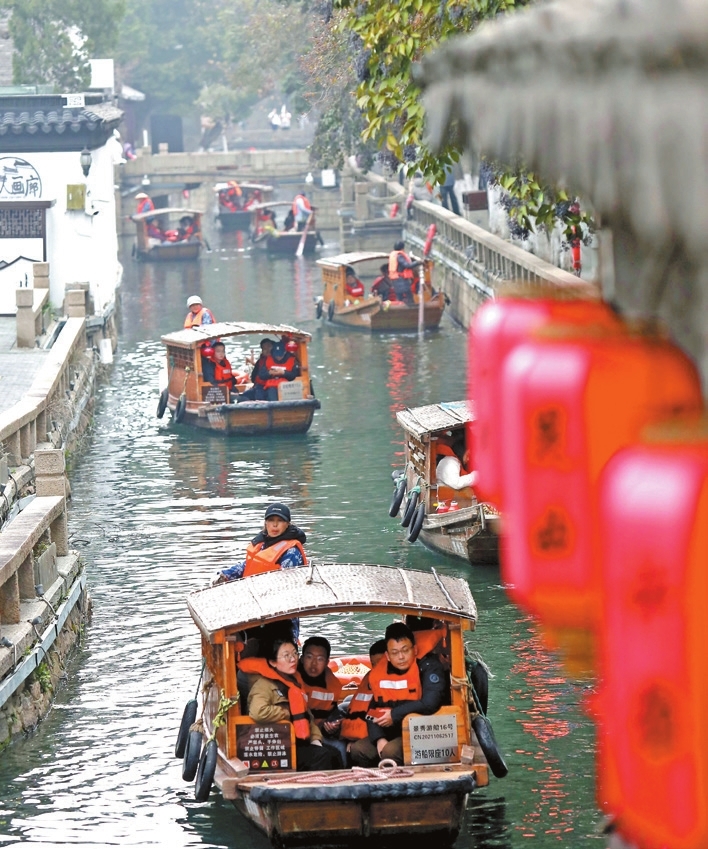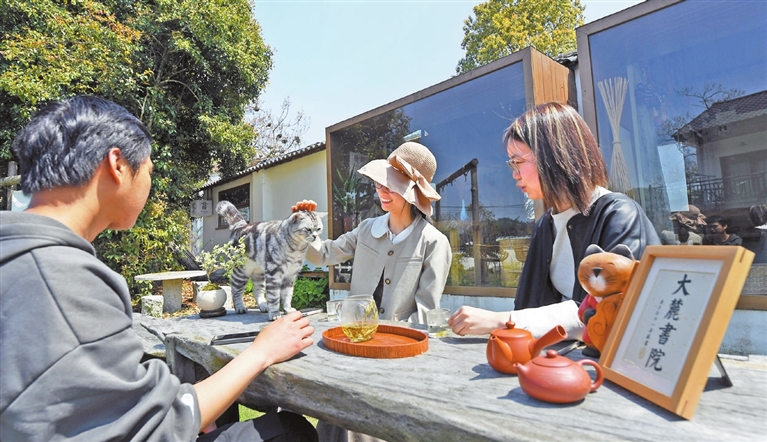


AS neo-Chinese style tourism, county tourism, and cultural and immersive experiences have become new keywords of holiday travel for Chinese tourists, destinations are striving to develop diverse tourism products and improve their services. Fueled by young people’s passion for traditional culture, tourism activities like Hanfu photography and immersive cultural performances have surged in popularity. It’s also trendy for Chinese tourists to head to lesser-known counties to get a short break from the hustle and bustle of urban life. China’s tourism market is upgrading and driving economic growth. During the five-day May Day holiday this year, domestic tourist expenditures in China amounted to 166.89 billion yuan (US$23.5 billion), up 12.7% from the same period in 2023. In 2024, Chinese tourists are estimated to make more than 6 billion trips across the country. Neo-Chinese style In East China’s Jiangsu Province, the Pingjiang Road historical and cultural block in Suzhou bustles with visitors even in the off season. Many people’s to-do lists include tasting a cup of tea while watching a Suzhou Pingtan musical performance in the local dialect or taking pictures in traditional Chinese Hanfu clothing. In a traditional clothing store on Pingjiang Road, young women are busy selecting outfits. The sales volume of cheongsam, waistcoats, and horse-face skirts has seen a sharp rise this year, which shows the integration of traditional culture and clothing into Chinese people’s daily lives, said Zhou Liyan, the owner of the store. A growing number of young Chinese are trying to enjoy their journey while pursuing traditional culture. Neo-Chinese style tourism saw a boom this May Day holiday, featuring cultural experiences such as ancient town tours, intangible cultural heritage exploration, and museum visits, among others. Data from Tongcheng Travel shows that bookings of tourist spots like museums and ancient towns saw a fourfold increase year on year during the five-day holiday. To the counties During this May Day holiday, Liu Shibin and his family from Northeast China’s Jilin Province traveled to the neighboring Liaoning for an “idle” vacation in Changhai County, Dalian City. They enjoyed clam digging and fishing amidst the cozy ocean breeze. “We wanted to temporarily escape urban life and spend five days on the island at leisure,” said Liu. Changhai County, which consists of five main islets, received some 25,000 visitors during the holiday, up 43.8% from the same period in 2019. Since the beginning of this year, China’s domestic tourism market has been steadily recovering. Some third- and fourth-tier cities and counties with unique cultures and natural landscapes have been well-received, as they are often cost-effective compared to traditional tourist destinations. Counties have become the new darling of Chinese tourists, particularly young people. Data from China’s leading travel platform, Ctrip, shows that during this May Day holiday, the county-level markets scored faster growth than third- and fourth-tier cities, whose growth again beat first- and second-tier cities. Qin Jing, vice president of Ctrip, attributed the county tourism fever to the public’s preference for cost-effective and comfortable experiences. During the May Day holiday, Anji County in East China’s Zhejiang Province, known for its picturesque rivers and mountains, witnessed an influx of over 1.67 million visitors. A local coffee shop served more than 7,940 cups of coffee in a day. “Counties with a slow pace of life allow visitors to savor local customs and culture,” said Yang Tianming, a tourist from South China’s Guangzhou. Yang added that nowadays, many of his friends are no longer solely interested in visiting popular destinations. “Instead, they prioritize enjoyable experiences when traveling.” China’s improved traffic network, including high-speed railways, airports, highways, and other infrastructure, ensures the accessibility of once-sleepy counties and is a booster for the holiday tourism boom. Currently, China’s railway services cover 81% of the country’s counties, and its bullet trains can reach 93% of the cities with a population of more than 500,000. “The popularity of county tourism is on the rise as the local infrastructure continues to improve. This satisfies travelers’ desire for a leisurely vacation while also offering unique experiences that blend with local cultures,” said Liu Yang, chief commercial officer of Tujia, a Chinese homestay booking platform. The counties are embracing an influx of visitors by upgrading infrastructure and offering diversified experiences such as camping and music festivals. Since December 2023, a total of 127 4A-level scenic spots have been added in 10 provincial-level regions across China, 65% of which are distributed in counties and county-level cities. Since the beginning of this year, Ctrip alone has added approximately 1,000 bookable county-level destinations. Immersive experiences As the aroma of wheat spreads across fields on the outskirts of Zhengzhou, the capital of Central China’s Henan Province, Zhu Yaru begins her sightseeing at “Unique Henan: Land of Dramas,” an immersive theater complex in Zhongmu County. The site comprises 21 theaters, in which various shows are themed on Henan’s history and the Yellow River culture. “While watching the plays about Su Shi, I felt like I was talking to the Song Dynasty (960-1279) poet himself and experiencing his life. That’s amazing,” Zhu said. During this year’s May Day holiday, the theater complex became a big hit. “A total of over 500,000 tourists came to enjoy the performances at the complex, increasing revenues by 40% year on year,” said Liu Kaipeng, head of the brand department of Henan Jianye Cultural and Tourism Marketing Center. Last year, the theaters received more than 12 million visitors, including foreigners from over 40 countries. Nowadays, the immersive experience has become a buzzword in China’s cultural and tourism industry, captivating travelers worldwide. In Xi’an, Shaanxi Province, the “24 Hours of Chang’an” theme park vividly reproduces the urban life of the Tang Dynasty (618-907). In Kaifeng City, Henan Province, people can travel back to the Song Dynasty in the Millennium City Park. Also, in Lijiang, Yunnan Province, the large-scale live show “Impression Lijiang” leads the audience to experience the lives of various ethnic minorities. “Chinese tourists are no longer satisfied with sightseeing. They long for unique experiences and wish to bond with local people and their culture,” said Xiao Jianyong, deputy head of the Henan Cultural Tourism Research Institute, adding that immersive experiences serve to promote the local culture and customs.(Xinhua) | 
